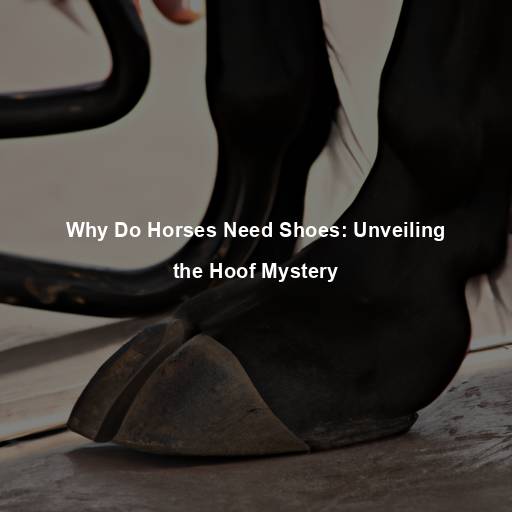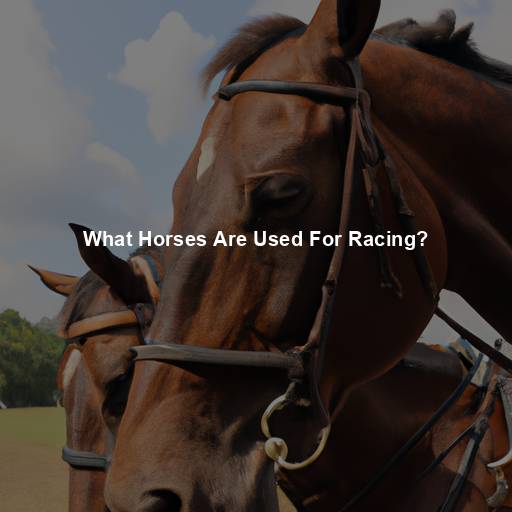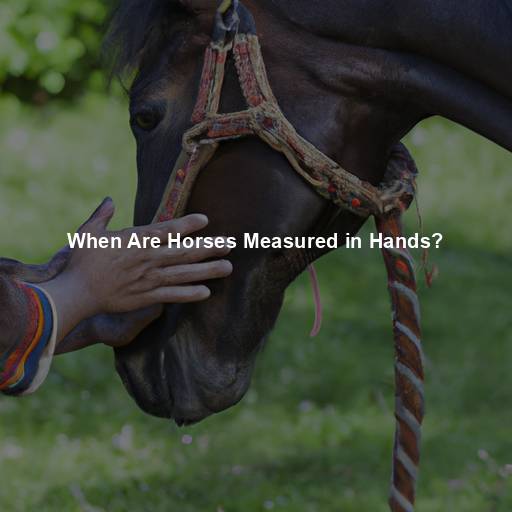Why Do Horses Need Shoes: Unveiling the Hoof Mystery
Last Updated on October 25, 2023 by Evan
Contents [hide]
- 1 Understanding the Equine Hoof: A Fascinating Structure
- 2 The Need for Shoes: Addressing Common Misconceptions
- 3 Reasons for Shoeing: Supporting Hoof Health
- 4 The Importance of Proper Hoof Care and Farrier Expertise
- 5 Alternative Hoof Care Methods: The Barefoot Approach
- 6 Common Hoof Problems and Their Prevention
- 7 Continual Care: The Key to Healthy Hooves
- 8 Emerging Trends in Hoof Care: Advances and Innovations
- 9 The Hoof: A Window to Equine Health
- 10 FAQs for the topic: Why do horses need shoes?
Understanding the Equine Hoof: A Fascinating Structure
The equine hoof is an intricate and vital part of a horse’s anatomy. Composed of a tough outer layer called the hoof wall, a sensitive inner layer known as the laminae, and a central region called the sole, the hoof plays a crucial role in the horse’s overall health and well-being. To comprehend why horses need shoes, we must first delve into the remarkable design of their hooves.
Hoof Function: More Than Meets the Eye
The majestic hoof, a marvel of equine engineering, silently safeguards the delicate inner workings. With grace and resilience, it bears the weight of the noble steed and gracefully absorbs the reverberating shocks of every stride. Tirelessly toiling, it grants unparalleled traction, flawlessly choreographing the horse’s rhythmic dance. A humble hero, the hoof preserves equilibrium, an unsung architect of balance and steadfast stability.
The Natural Hoof vs. the Domesticated Horse
In the wild, horses roam across varied terrains, which helps naturally wear down their hooves and keep them in optimal condition. However, domestication has brought horses into more controlled environments, including stable floors and hard surfaces. These changes disrupt the natural wear and tear process, leading to potential hoof problems.
The Need for Shoes: Addressing Common Misconceptions
Misconception 1: Horses Always Need Shoes
Contrary to popular belief, not all horses require shoes. Many factors influence the need for shoeing, such as the horse’s workload, conformation, and hoof health. While some horses can thrive without shoes, others may require the additional support and protection they provide.
Misconception 2: Shoes Weaken Hooves
Another common misconception is that shoeing weakens the hooves. However, when done correctly and with proper maintenance, shoeing can actually aid in preserving and improving hoof health. Regular farrier visits and appropriate shoeing techniques ensure the hooves remain strong and functional.
Misconception 3: Barefoot is Always Better
The fascinating world of barefoot hoof care has been making waves in the equestrian community, but let’s unravel the complexity behind this trend. As intriguing as it sounds, we must acknowledge that not all horses tread the same path when it comes to going shoeless. With some gracefully adapting to the barefoot lifestyle, there are those who encounter perplexing challenges on unforgiving terrain or due to unique hoof conditions. Hence, it becomes crucial to approach the decision of shoeing or going barefoot with a discerning eye, taking into account the horse’s distinct needs and circumstances.
Reasons for Shoeing: Supporting Hoof Health
Protection and Support
Shoes provide an additional layer of protection for the hooves, particularly in horses engaged in demanding activities such as jumping, racing, or long-distance riding. They help prevent excessive wear, bruising, and injury caused by uneven terrain, sharp objects, or repetitive impact.
Correcting Hoof Imbalance and Conformation Issues
When it comes to our equine friends, sometimes nature throws a curveball with conformational quirks and weight imbalances, leaving their hooves in a bit of a frenzy. Fear not! The magic of shoes, combined with expert trimming techniques, can swoop in like a superhero and save the day. By working their wonders, these tools help restore equilibrium, preventing any hint of lameness or pesky long-term damage.
Enhanced Traction
For horses participating in disciplines that require precise movements or rapid changes in direction, shoes with specialized treads offer improved traction. This added grip can prevent slipping and provide the necessary stability for optimal performance and safety.
Therapeutic Shoeing
When it comes to hoof ailments, injuries, or pesky lameness woes, therapeutic shoeing comes to the rescue as a nifty treatment option. By crafting bespoke footwear, utilizing special pads, or incorporating fancy wedges, this technique works wonders in offering support, alleviating pressure, and kickstarting the healing journey. With this magic touch, our equine friends can say goodbye to their hitched gait woes and strut their stuff in style once again.
The Importance of Proper Hoof Care and Farrier Expertise
It is essential to emphasize that the decision to shoe a horse should be made in consultation with a knowledgeable farrier or equine veterinarian. These professionals possess the expertise to assess hoof health, identify individual needs, and recommend appropriate shoeing techniques, if necessary. Regular hoof care, including trimming and maintenance, is crucial for overall hoof health, regardless of whether a horse wears shoes or not.
A Balanced Diet for Strong Hooves
Proper nutrition plays a significant role in maintaining healthy hooves. Horses require a balanced diet that includes essential nutrients such as proteins, vitamins, minerals, and fatty acids. These nutrients contribute to the development of strong, resilient hooves. Insufficient intake of key nutrients can lead to weak, brittle hooves that are more prone to damage and infection.
The Impact of Hoof Supplements
When it comes to horses’ hoof health, there’s a buzz about the potential wonders of hoof supplements. Packed with biotin, methionine, zinc, and copper, these supplements claim to work magic on hoof growth and structure. But hold your horses – don’t saddle up just yet. The effectiveness of these supplements can be as unpredictable as a bucking bronco, so it’s crucial to consult with a trusted vet or equine nutritionist before hitching your horse to the supplement wagon.
Alternative Hoof Care Methods: The Barefoot Approach
The Barefoot Movement: An Alternative Perspective
Over the past few years, there has been a growing interest in the barefoot movement among horse owners and enthusiasts. This unconventional approach to hoof care has sparked a wave of discussion and debate. Advocates of barefoot hoof care passionately argue that it fosters natural hoof function, enhances shock absorption, and ultimately strengthens the horses’ hooves. By allowing horses to navigate different terrains sans shoes, supporters firmly believe that these majestic creatures can adapt and thrive in ways we once thought impossible.
Considerations for Going Barefoot
Before transitioning to a barefoot lifestyle, several factors should be taken into account. These include the horse’s conformation, workload, and hoof health. Some horses may struggle with certain terrains or hoof conditions, making shoes necessary for their well-being. It is crucial to work closely with a knowledgeable farrier or barefoot hoof care specialist to assess the horse’s suitability for going barefoot and to ensure a smooth transition.
Maintaining Barefoot Hooves
Maintaining the health and strength of barefoot hooves is a task that demands attention and care. Regular upkeep, such as trimming and maintaining proper hygiene, is crucial to prevent untamed growth and preserve the hooves’ natural shape and equilibrium. Furthermore, engaging in diverse terrains during routine exercise can aid in fostering robust and thriving barefoot hooves. It’s a fascinating journey that unveils the hidden secrets of equine podiatry!
Common Hoof Problems and Their Prevention
Laminitis
Laminitis is a painful and potentially debilitating condition that affects the laminae, the sensitive structures within the hoof. It can be caused by various factors, including diet, obesity, metabolic disorders, or excessive workload. Proper nutrition, weight management, regular exercise, and appropriate hoof care are essential in preventing laminitis.
Thrush
If you’re a horse owner, you’ve probably heard of the dreaded thrush – a sneaky bacterial infection that loves to target the frog of the hoof. This little troublemaker thrives in damp and grime-filled places, creating a stench that could make your nose curl. Not only that, it can leave your horse with gloomy black tissue that screams trouble. Fear not, though!
White Line Disease
White Line Disease, also known as seedy toe, is a fungal or bacterial infection that affects the inner layers of the hoof wall. It causes the separation of the hoof wall from the underlying structures, leading to weak and compromised hooves. Proper hoof hygiene, regular farrier visits, and avoiding prolonged exposure to wet environments can aid in the prevention of white line disease.
Hoof Abscesses
When it comes to hoof health, one issue that frequently leaves horse owners in a state of perplexity is the dreaded hoof abscess. These localized infections, which can arise from a variety of culprits including foreign objects, trauma, or bacterial invasion, are notorious for causing not only severe pain but also lameness. Thankfully, there are steps that can be taken to minimize the risk of these troublesome abscesses, such as diligent hoof care, prompt treatment of underlying issues, and maintaining clean and hygienic stable conditions.
Continual Care: The Key to Healthy Hooves
Hoof health is an ongoing process that requires regular care and attention. Here are some key points to keep in mind:
Ensuring the well-being of our equine friends requires a diligent approach. It’s essential to establish routine rendezvous with a skilled farrier or barefoot hoof care specialist, to guarantee optimal hoof balance, promptly address any concerns, and make informed decisions about shoeing. By embracing this proactive practice, we navigate the equestrian world with clarity amidst the captivating complexity of equine hoof care.
– Practice good hoof hygiene by cleaning the hooves daily, removing debris, and keeping the hooves dry to prevent the development of infections.
– Provide a well-balanced diet that meets the nutritional needs of your horse, ensuring the intake of essential nutrients for strong hooves.
How often do we think about the health of our horse’s hooves? It’s easy to forget that regular exercise, especially on different terrains, can actually have a profound impact on their hoof development. By engaging in a diverse range of activities, we can help strengthen the supporting structures and ensure our equine companion’s overall well-being. Let’s delve into the fascinating world of hoof health and discover the wonders that a little variety can do for our four-legged friends.
Keeping a keen eye on your horse’s hooves is of utmost importance, as even the slightest inkling of lameness, injury, or peculiarities could unravel into grave complications if left unattended. By promptly identifying and tending to these issues, you can effectively safeguard your equine companion’s well-being and avert potential setbacks. Remember, vigilance and early intervention are key to maintaining your horse’s overall health and soundness in the long run.
– Stay informed about the latest advancements and research in hoof care to make informed decisions regarding your horse’s hoof health.
In the equestrian world, the key to preserving the vitality and soundness of our beloved equines lies in a continuous commitment to their hoof health. By embracing a holistic approach that combines expert advice with unwavering vigilance, horse owners can navigate the intricate landscape of hoof care and provide their noble companions with the gift of longevity. Whether opting for conventional shoeing techniques or embarking on unconventional paths, the ultimate objective remains resolute: to foster resilient and functional hooves that empower these majestic creatures to flourish in their multifaceted roles and ever-changing surroundings. Step by step, hoof by hoof, we embark on a perplexing journey of maintaining equine well-being, all while celebrating the enigmatic beauty and enigmatic nature of these awe-inspiring creatures.
Regular Hoof Inspection
When it comes to keeping your horse’s hooves in top shape, vigilance is key. Make it a habit to closely examine your horse’s hooves on a daily basis, keeping an eye out for any unusual marks, redness, or irregularities. Take note of the hooves’ color, warmth, and scent – these seemingly simple observations can provide valuable insights into your horse’s hoof health and help you catch any potential problems early on.
Hoof Cleaning and Hygiene
When it comes to hoof care, maintaining proper hygiene is of utmost importance. Make it a daily ritual to thoroughly cleanse the hooves, bidding adieu to the remnants of dirt, debris, and, well, manure. Employ the magical prowess of a trusty hoof pick to delicately excavate any stubborn buildup residing within the intricacies of the hoof, taking special care to ensure that those lovely frogs are smudge-free. Oh, and let’s not forget to shield those precious hooves from the perils of prolonged exposure to moist and muddy surroundings, for they have the uncanny ability to weaken the hooves and invite unwanted infections.
Regular Trimming and Maintenance
When it comes to horses, hoof growth is a bit of a puzzle. Each horse has its own unique hoof growth patterns, making it a bit of a guessing game. That’s why it’s crucial to enlist the help of a skilled farrier who can navigate the maze of hooves and provide regular trimming to keep things in check. By maintaining proper hoof balance, we can prevent those pesky cracks and splits and ensure our four-legged friends are trotting along with optimal weight distribution and overall hoof health.
Appropriate Shoeing Techniques
When it comes to keeping your horse’s hooves in tip-top shape, it’s no walk in the park. Seeking out the expertise of a skilled farrier is an essential step on this perplexing journey. With a wide array of shoeing techniques tailored for various disciplines, it’s important to find the right fit for your equine companion – whether it be racing plates to amp up their speed, eventing shoes for those daring jumps, or therapeutic shoes to address any hoof issues they might have. Your trusted farrier will carefully assess your horse’s conformation, workload, and individual hoof concerns to ensure they receive the perfect footwear, leaving hoof enthusiasts bursting with delight.
Balancing Workload and Rest
Taking proper care of your horse’s hooves is of utmost importance, especially when they are involved in demanding activities or high-performance disciplines. Striking a harmonious balance between their workload and rest periods becomes crucial to prevent overexertion and minimize the chances of hoof fatigue or injury. Giving your equine companion enough time to recuperate and rejuvenate after intense workouts is vital, and don’t forget to embrace the benefits of regular turnout to encourage natural movement and stimulate their hooves.
Emerging Trends in Hoof Care: Advances and Innovations
Natural Balance Trimming
Natural balance trimming is an approach that aims to replicate the natural shape and balance of the hooves. It focuses on maintaining proper hoof angles, toe length, and heel height to promote optimal weight distribution and hoof function. This technique can be beneficial for horses that are transitioning to a barefoot lifestyle or those with specific conformational issues.
Composite Materials for Shoeing
Over the past few years, there has been a remarkable surge in the admiration for composite materials as a viable substitute for the age-old metal footwear. With the advent of polyurethane and synthetic polymers, the game has changed entirely. These revolutionary materials not only boast the extraordinary ability to absorb shocks but also significantly cut down on weight and enhance flexibility. The beauty of composite shoes lies in their ability to offer optimal support and protection while minimizing the detrimental consequences typically brought about by the rigid metal counterparts.
3D Printing in Hoof Care
In the ever-evolving realm of technology, 3D printing has ventured into the unexpected realm of hoof care. This means that gone are the days of ordinary horseshoes; instead, bespoke footwear and ingenious hoof orthotics can now be crafted using this cutting-edge innovation. The beauty of this technological breakthrough lies in its ability to provide a flawless and personalized fit, especially for intricate hoof conditions and specialized therapeutic requirements. With 3D printing at the forefront, the field of hoof care has been elevated into an era of unrivaled customization and mind-boggling creativity.
The Hoof: A Window to Equine Health
Hoof Signs of Overall Health
Have you ever wondered how a horse’s hooves can reveal so much about its health and overall well-being? It’s truly fascinating how these seemingly inconspicuous features hold a secret world of information. Picture this: healthy hooves, like warriors of resilience and strength, boast distinctive characteristics that unveil tales of vitality and robustness. So next time you find yourself marveling at a horse’s hooves, remember that they are much more than meets the eye – they are enigmatic windows into a horse’s extraordinary world.
With a remarkable depth and concavity, these shoes offer an exceptional level of comfort and support for your feet. Embrace the burst of relief as you step into the perfect fit and feel the perplexity melt away. Experience a unique sensation that will leave you questioning how you ever lived without these remarkable soles.
– Uniform hoof wall growth and lack of cracks or splits.
– Healthy coloration, usually ranging from pale pink to dark gray.
– Well-developed frogs that are free of infection or thrush.
Discover the secret to conquering discomfort one step at a time with the latest in footwear innovation. Experience unparalleled stability and optimal weight dispersion as you gracefully glide, leaving behind the woes of uncomfortable heels. Elevate your stride with the perfect blend of support and balance, paving the way for a confident, effortless journey.
The Importance of Collaboration
Taking care of a horse’s hooves is a team effort that involves owners, farriers, and equine healthcare experts. The key to success lies in open communication and consistent collaboration, which guarantees that the horse’s unique requirements are met and any possible complications are swiftly detected and resolved. It is crucial to be proactive and seek professional counsel and support, as timely intervention can mitigate future complications and enhance overall hoof health. Embrace this collaborative approach and unlock the potential for optimal equine hoof care.
FAQs for the topic: Why do horses need shoes?
Why do horses wear shoes?
While horses may seem perplexing creatures, their choice to don shoes is no mystery. These equine fashion statements serve a dual purpose that goes beyond mere style. Firstly, the shoes offer a protective shield, safeguarding their sensitive hooves from the harsh trials of the ground, preventing unnecessary wear and tear. Moreover, these footwear marvels enhance their grip on various treacherous terrains, allowing horses to strut with confidence and grace, as well as preventing any disastrous missteps that could unbalance their elegant gallop.
Do all horses need shoes?
The choice to shoe or not to shoe a horse is no simple task, with a whirlwind of factors swirling in the mix. Work type, hoof condition, and the living environment all dance together in a perplexing waltz, ultimately determining if hoof protection is an absolute necessity. For those equine companions engaging in spirited pursuits like racing, jumping, or embarking on arduous long-distance rides, the added support of shoes can prove invaluable. Yet, horses roaming idyllically in the embrace of untamed nature have the chance to hone their hooves as they roam, potentially evading the need for such artificial accoutrements.
How often do horses need new shoes?
When it comes to the precarious world of horse shoeing, the frequency of hoof transformations can leave even the most seasoned equestrians in a state of bewilderment. A perplexing dance between workload, terrain, and hoof health dictates the rhythm at which shoes are cast aside in favor of fresh footwear. On average, horses embark on this journey every 4 to 8 weeks, but hold your reins tight, for outliers exist! Some equine creatures, with their hooves growing at a pace that defies logic, or those partaking in shoe-destroying exploits, demand more frequent visits to the forge. Embrace the baffling intricacies of this arcane art, as the horses’ fancy footwork takes center stage in this ever-evolving saga of horseshoe obscurity.
Can horses go without shoes?
It’s a question that has puzzled horse enthusiasts for ages – can horses really thrive without shoes? The answer, quite surprisingly, is yes! In their natural habitat, these majestic creatures have honed their hoof maintenance skills through traversing various terrains – mother nature’s own personal pedicure routine. However, in the world of domestication, factors such as extensive workloads, unfamiliar landscapes, or unique hoof conditions may call for a little extra TLC in the form of shoes. Fear not, though, for with regular farrier check-ups and proper care, the decision to let those hooves roam wild and free is not one to be taken lightly.
Do all horse breeds need shoes?
Horseshoes: To Shoe or Not to Shoe, That Is the Question
When it comes to horses and their unique needs, one of the most debated topics revolves around the necessity of horseshoes. The complexity arises as it becomes apparent that not all horse breeds require these protective accessories. Instead, the decision to shoe or not to shoe relies on a multitude of factors that intertwine to create a perplexing puzzle. Workload, terrain, and the quality of their hooves all play a significant role in determining whether a horse will benefit from the added support of shoes. While certain breeds may be predisposed to particular hoof conditions, it is crucial to remember that this is not a blanket rule that applies to all equine individuals of that breed. So, to shoe or not to shoe? The answer lies within the intricate tapestry of each horse’s unique circumstances.







